Intravenous hydration drips, celebrity healers, and crystal therapy: Inside the very first Goop summit
Culver City, CA
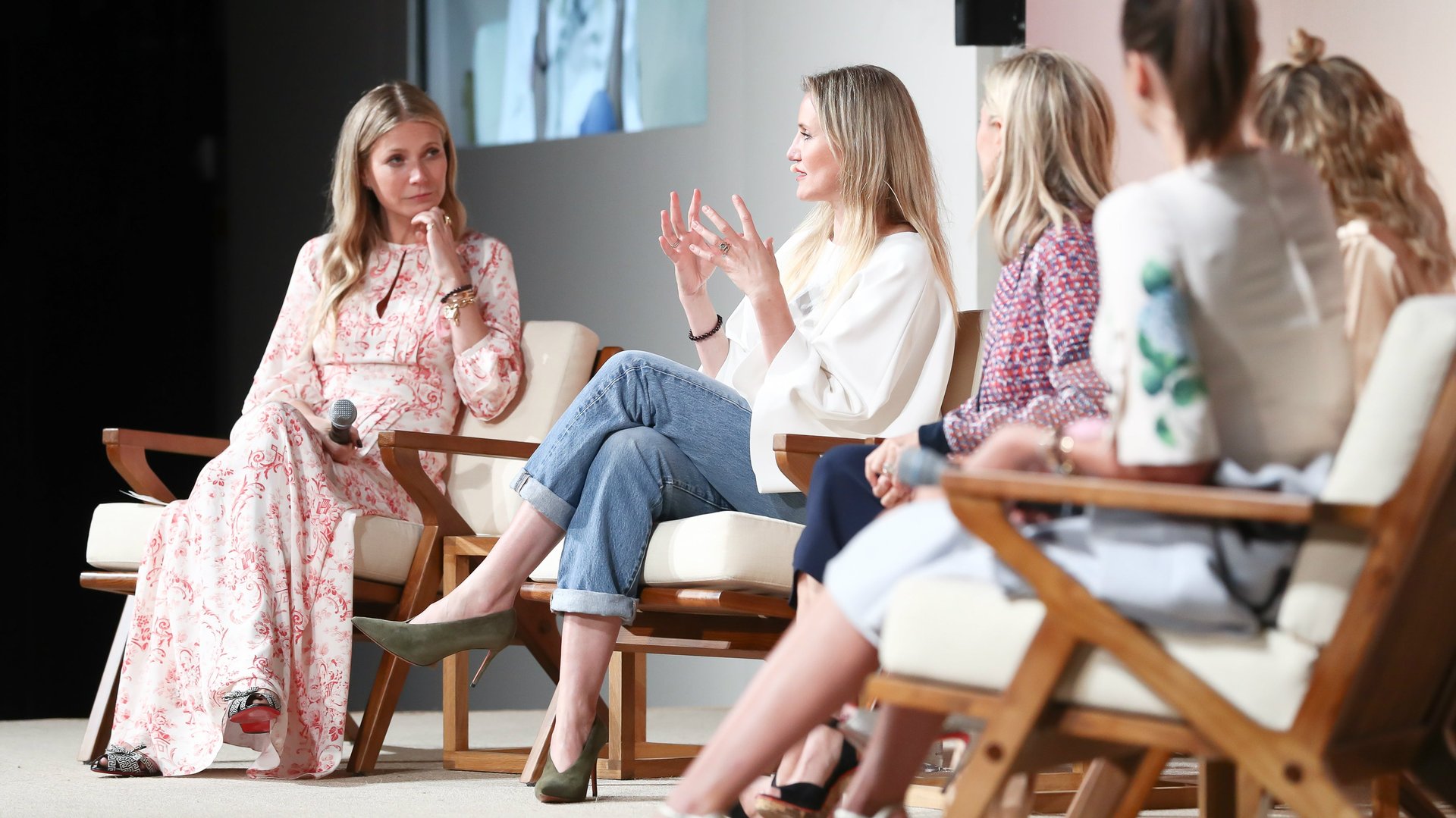

Culver City, CA
The first thing you learn at In Goop Health, the inaugural wellness summit from Gwyneth Paltrow’s lifestyle brand, Goop, is that wellness is “a journey.” You will hear this multiple times over the course of the day—from doctors, from attendees, and from Paltrow herself.
The journey of this day, for which approximately 600 guests (Goopies?) paid between $500 and $1,500 per ticket, begins in a parking lot-turned-patio, kitted out with sisal rugs, furniture you might find on the roof of a luxury hotel, and long wooden tables. Around the patio’s edges, vendors such as Moon Juice offer snacks and drinks like “Brain Dust Blue Tonic,” and Goopies—almost all white women—line up for a variety of services included with the price of admission.
In one corner of the lot, staffers in black scrubs hook apparently healthy guests up to IV drips filled with saline—a Paltrow-approved hangover remedy. Beside them, other Goopies sit with pastel-colored oxygen tubes snugly beneath their nostrils, getting a bit of fresh air to start the day. At the patio’s entrance, a woman wearing an “In Goop Health” t-shirt preside over about 20 bowls of various smooth gems, arranged atop a layout of beach blankets, white shag rugs, and floor cushions: a “crystal therapy” station. By 10am, the crystal therapist is entirely booked for the day. But the longest line by far snakes from the entrance of a miniature white dome: a studio for “aura photography,” an attractive, semi-spiritual selfie to commemorate the occasion—a Goop-y souvenir, indeed.
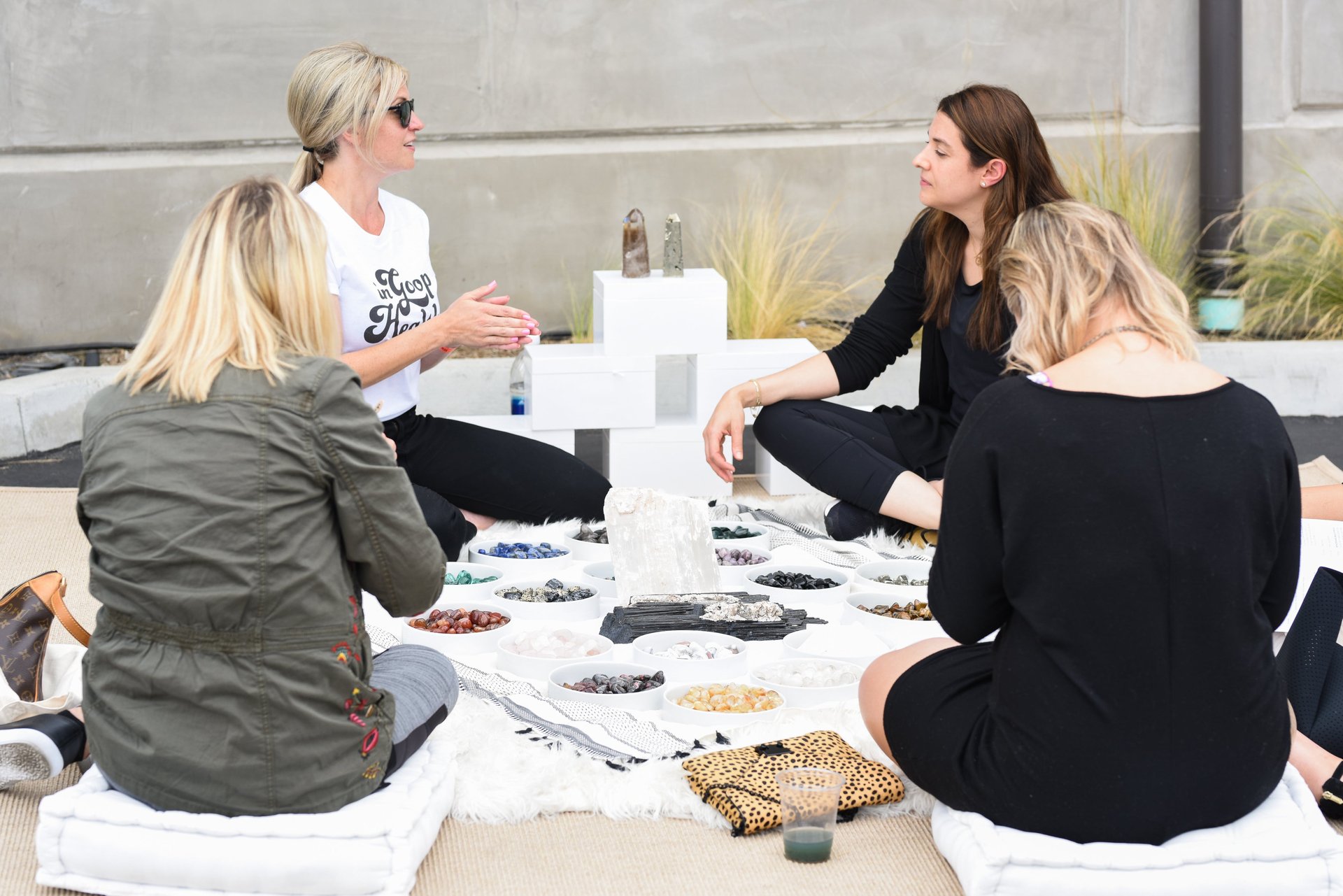
Goop, for the uninitiated, is Gwyneth Paltrow’s growing lifestyle brand, which secured $10 million of venture capital in 2016. What started as an email newsletter in 2008 has expanded to include an editorial website with advice-dispensing articles by staff writers and outside contributors; an online boutique of clothing, accessories, housewares, and beauty products; and a Goop-branded line of clothing, fragrance, skincare, vitamin supplements, and—as of this weekend—experiences.
Once upon a time, a Birkin bag, a Gobstopper-sized diamond ring, or shoulders sun-bronzed on a seaside holiday signified wealth and access to the finer things in life. Today, Birkins are easily knocked off (or rented), Gobstoppers are gauche, and a suntan can be sprayed on in a matter of minutes. On Saturday, only a small handful of Goopies in attendance carried recognizably designer handbags, and many favored leggings and sneakers over more formal attire. Forget conspicuous consumption, for these Goopies, and thousands more like them, the ultimate luxury is investment in one’s self—more specifically, one’s wellness.
Welcome to the epicenter of the wellness industrial complex.
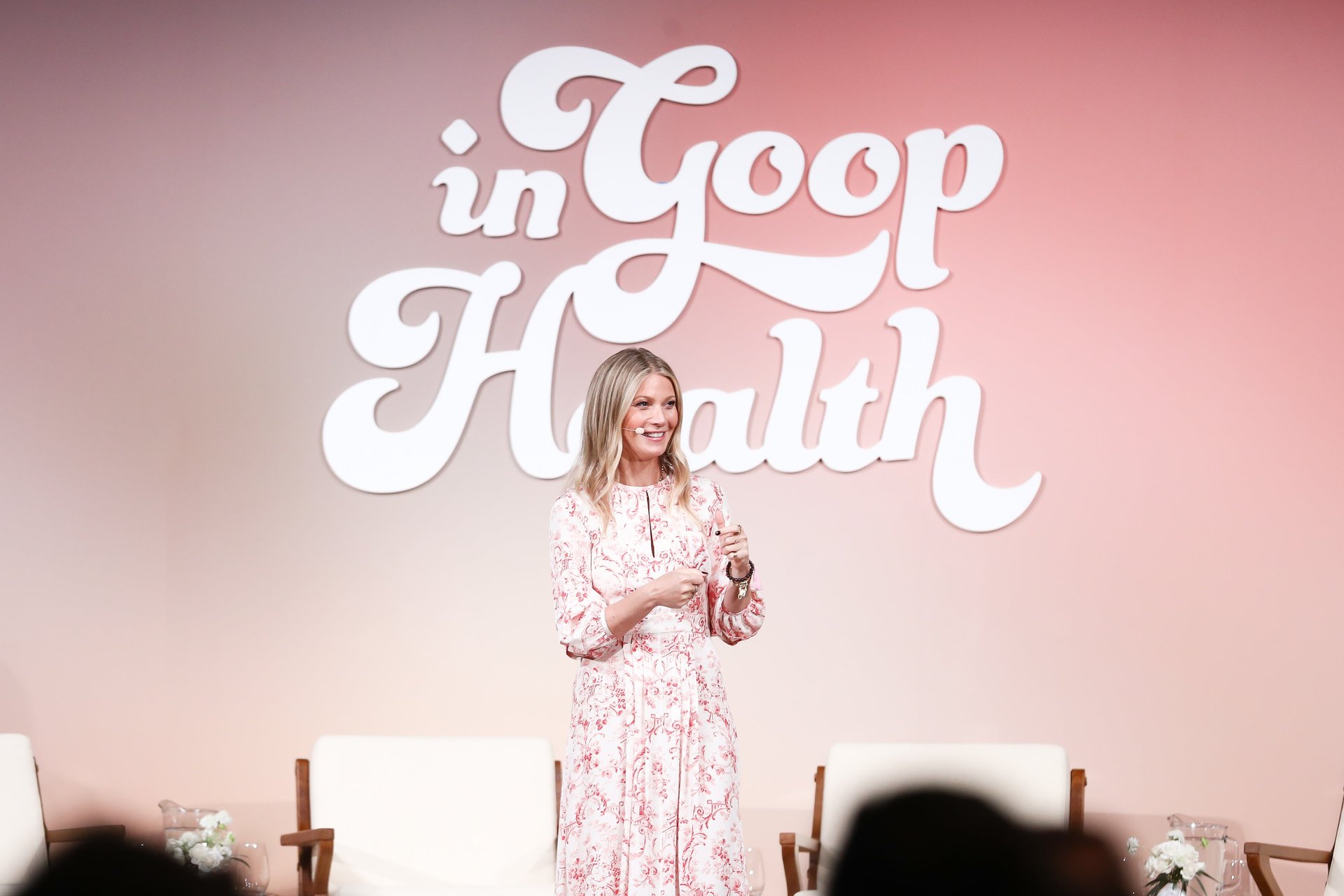
“Good morning!” exclaimed Paltrow, as she strode across the stage of a raw, high-ceilinged events space. She wore a long-sleeved, cream-colored dress with a red, wallpaper-ish toile print and a TED-style headset mic—except peach-colored instead of black. She looked like Gwyneth, 2.0. Everyone cheered.
“My journey to wellness really started in about 1997,” said Paltrow. “My father was diagnosed with throat cancer. I very quickly went from being a chain-smoking Camel Light girl to starting to try to understand why my father had cancer.”
She went on to tell a tale of baking her late father a gluten and sugar-free zucchini loaf, which he compared to biting into The New York Times, and then the story of her initiation into alternative diets and therapies, “through my macrobiotic phase and through starting up riots because I had cupping marks on my back.”
“Today really comes out of my curiosity, my deep curiosity, my willingness to try to do everything I can to live a life that feels really good to me, whether that’s in relationships, food, body, mental health,” she said. “And it really is a journey.”
The wellness industrial complex
This wellness journey, of course, is not to be confused with plain old health. More than just a person’s ability to function free of ailments, wellness refers to the overall sense of well-being that results when one’s mind, body, and spirit are operating at their optimum potential.
The Oxford English Dictionary traces the word back to the 1650s, and wellness practices often reference centuries-old traditions such as Chinese and Ayurvedic medicine. But according to the New York Times Magazine’s Ben Zimmer, the wellness movement we recognize today started in the 1950s when Halbert L. Dunn, chief of the National Office of Vital Statistics, used the term “high-level wellness” to describe “an integrated method of functioning, which is oriented toward maximizing the potential of which the individual is capable.” Dunn and his disciples went to great lengths to avoid association with the sort of quackery that has permeated the pursuit of wellness; the anti-masturbation crusader John Harvey Kellogg’s turn-of-the-century Battle Creek Sanitarium, immortalized in the novel and film The Road to Wellville, comes to mind.
Unlike health, which can describe an achievable state (as in, “I’m healthy”), wellness—as defined by The National Wellness Institute, an association of “wellness professionals” founded in 1977—”is an active process through which people become aware of, and make choices toward, a more successful existence.” Wellness, you see, is not simply a state of being. Wellness—according to Paltrow’s doctors and disciples—is a journey, a process, an aspiration, and, increasingly, a business.
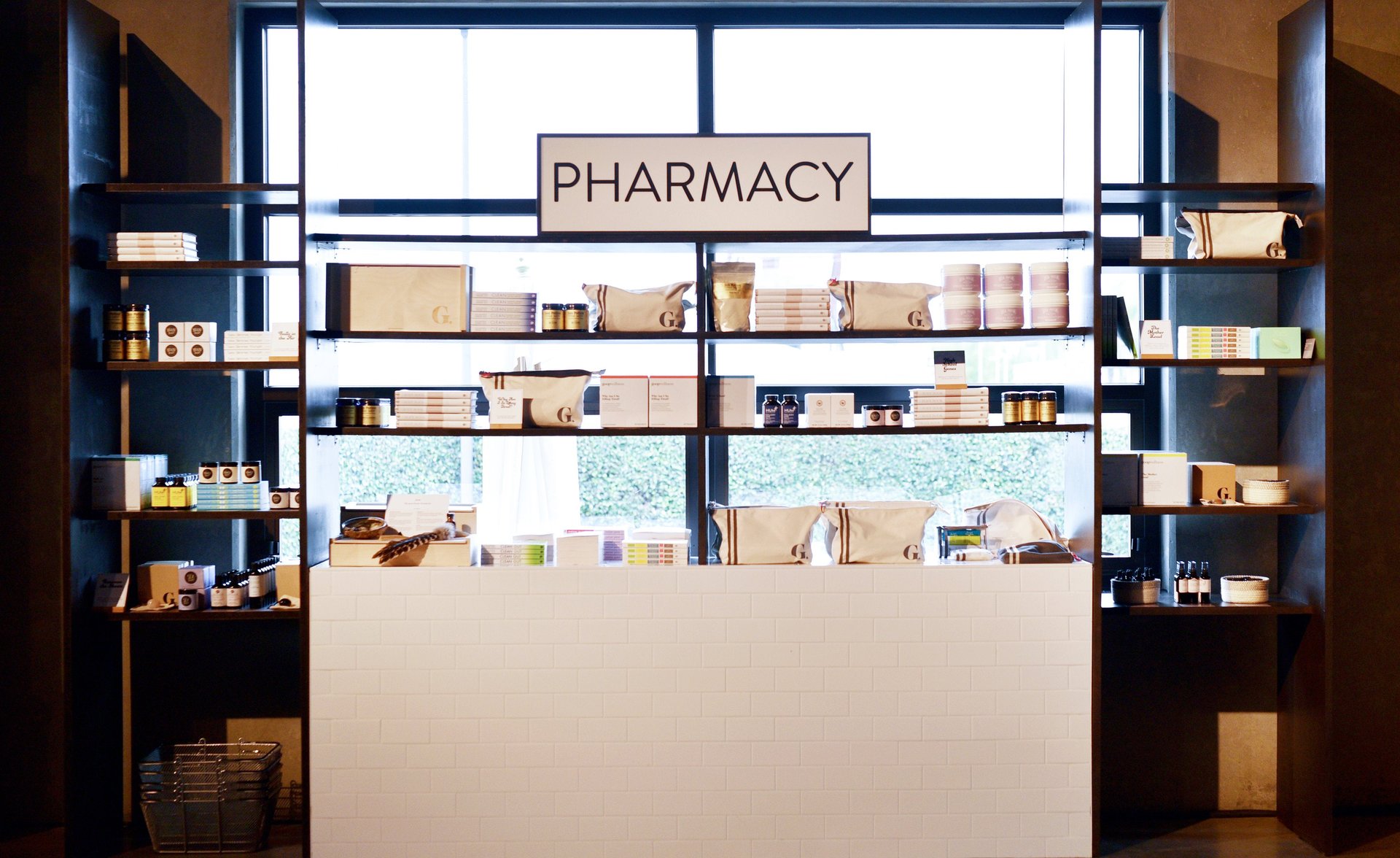
Inside “Goop Hall,” a raw events space with soaring ceilings, that served as a lobby between the outdoor treatments and the theater for panels and speakers, Goopies took photos in front of an “In Goop Health” step-and-repeat wall of succulents, and browsed shelves of Goop-branded skincare and supplements, as well as Tata Harper cosmetics, Tory Burch workout clothes, Staub kitchenwares, and more. (Goop also probably sold a dress or two for online fashion retailer Net-A-Porter during the conference. When Paltrow emerged onstage, a woman beside me in the theater whispered, “Her dress is so beautiful!” Before the day was through, she had located it online, for $835.)
“The market is monstrous,” Jason Wachob, the founder of the wellness-focused media brand mindbodygreen, told the online publication The Business of Fashion in 2016. According to the market research firm Euromonitor, the food and beverage segment alone of the global wellness market was worth $703 billion in 2016, and is projected to grow to $833 billion by 2020. In 2016, The Business of Fashion’s Lauren Sherman noted that while sales for personal luxury items like high-end watches and handbags have flagged, the market for luxury experiences such as resort-based yoga retreats (and, ahem, summits), remained strong—more than half of a $1.8 trillion luxury market, according to a 2014 report from the Boston Consulting Group.
The transformation economy
Joseph Pine II, who co-authored the 1999 book The Experience Economy, says we can attribute this monstrous market to what he calls “the transformation economy.” That, he argues, is the latest step in a progression that has seen our consumer dollars shift over centuries, from commodities to goods, then services, then experiences—and now, finally, to personal transformations.
“[Consumers] are increasingly paying people to help them achieve their own aspirations. You see this a lot in anything called a ‘coach’ or a ‘trainer.’ You have a life coach, that’s a transformation company,” Pine told me over the phone. “Any company that says it wants to help make you healthy, wealthy, or wise is really in the transformation business…. We also recognize that, ‘This is the only life I have, I need to make the most of it. And so I need those experiences that are going to actually help me become who I want to be.’ I do think that’s clearly what business Gwyneth Paltrow is in.”
Pine said the aging Baby Boomers deserve as much—if not more—credit (or blame) than millennials for fueling the transformation economy.
Boomers were not in short supply at In Goop Health.
“You get to that middle place [in life] and that which you take for granted might not be here tomorrow,” said Andrea Lukens, a recent empty-nester who traveled the event from San Francisco, to attend with her friend, Stephanie Mayer. (The two women had met when their infants, now 20 years old, shared a nurse.) “It’s accepting responsibility for your yourself and your body—and your journey.”
“It’s a journey,” agreed Mayer.
“I am an animal!”
When I re-entered the theater (after waiting in line to pay $36 for a certified-organic lip and cheek tint, if we’re being honest) Jungian Hollywood power therapists Barry Michels and Phil Stutz, whose bestselling self-help book, The Tools, would be included in the day’s gift bags, had already taken the stage with Paltrow.
“People want more,” Stutz was saying. “It’s like a wave that’s sweeping the country right now.”
Paltrow asked if anyone in the audience had a question for Phil and Barry (as they are known in Hollywood), and before long, a woman wearing expensive-looking workout gear and fluffy red-streaked hair, was invited onstage; she introduced herself as Kathy.
Paltrow gave Kathy her chair, and sat cross-legged on the stage’s floor while Kathy cautiously told Stutz and Michels she was happy in her relationship, but dissatisfied that she and her partner lived in separate houses. A live video feed projected on either side of the stage zoomed in on her furrowed expression, lending the moment a sort of live talk-show style drama. I will spare you the details, but suffice to say that Kathy wasn’t feeling entitled enough—entitled in a positive sense, not the “Hollywood” sense, Paltrow clarified—to express her wishes to her partner. So Stutz told her to close her eyes, concentrate intensely on what she wanted, and silently say, to the universe: I demand it.
Then, the two therapists directed us to help Kathy, as a group, by first gathering the primal energy to yell simultaneously, “I am an animal!” (“You don’t fuck with this group!” yelled Paltrow, to resounding cheers afterward) and then channeling that energy toward Kathy while Michels guided her through the next step.
“Close your eyes again, and go back to that I want it state,” said Michels to Kathy, who took a deep breath. “Then, you guys go back to generating that ‘I’m an animal’ energy, and direct it right at her. She needs your support. This is like a sisterhood here. And Kathy, when you get to, ‘I demand it,’ really build it up in your heart. Feel like it’s the most important thing that you’ve ever asked of the universe. And then, after that, I want you to go to the third step, which is: I deserve it”
The camera zoomed in on Kathy, who licked her lips, her eyes lightly closed. After a long few seconds, she opened them.
“How do you feel?” asked Michels.
“Strong,” she responded, quietly. “I just felt a sense of support and strength and calm. How the hell did I get up here? It’s like some invisible force brought me up here.”
Afterwards, Kathy told me she had recently attended the Hoffman Process, a $4,700 one-week intensive therapy retreat. As passing Goopies praised her courage, called her “tiger,” and patted her shoulders, Kathy said her experience at In Goop Health gave her what she was looking for.
“It went viral”
Backstage at In Goop Health, doctors were ushered between reporters with the hushed efficiency usually reserved for movie stars. Oscar Serrallach, a general practitioner who focuses on postnatal care in a small town in Byron Bay, Australia, admitted the attention made him a bit nervous.
Serrallach said his “journey into wellness” began when he started a family while studying functional medicine—a specialty that focuses on patients’ “wellness processes” such as nervous system, hormonal balance, and stress management in addition to pathology. Serrallach observed new mothers—both in his personal circle and among his clients—who were struggling with exhaustion, anxiety, and pregnancy-triggered conditions.
“I kind of realized that the medical world doesn’t—apart from certain diseases and postnatal depression—doesn’t have anything to offer recovering mothers outside just the sort of general medical interventions,” he said.
Serrallach coined a phrase, “postnatal depletion,” for the conditions he was treating in patients. His friend Alejandro Junger—the doctor who Paltrow credits with starting her “journey” with her very first detox—introduced Serrallach to Goop. In 2015, the Goop site published a 3,000-word Q&A with Serrallach entitled “Postnatal depletion: Even 10 years later,” which outlined the causes and symptoms of the condition and suggested steps for recovery (including “go see a good functional health practitioner”).
“It went viral,” Serrallach said. “I think the big thing was just the acknowledgement that a lot of mothers who’d felt they’d been suffering alone, without support, just the acknowledgment to be heard.”

Since then, Serrallach has parlayed his research into The Mother Load, a Goop-branded dietary supplement that includes fatty acids, vitamins, and minerals similar to those he gives his patients in Australia, and a book, to be published under Goop’s imprint by Grand Central Publishing in 2018.
“It was kind of my calling to go, ‘You need to share this sort of information,'” he said, of his Goop debut.
Paltrow’s detractors say she is in the business of selling pseudoscientific snake oil in tasteful packaging at premium prices. To be sure, some of the products on Goop’s site (particularly the “Cosmic Health” section) border on parody. See: the “Goop Medicine Bag,” an $85 drawstring sack containing eight “magically charged stones; “Trauma Repair,” a scentless flower and “gem essence” blend in a $22 0.5-ounce dropper, and, of course, the $66 jade “yoni egg,” which set the internet alight when Goop published a Q&A with “beauty guru/healer/inspiration/friend” Shiva Rose, in which Rose suggested inserting the egg in one’s vagina could improve “your sex life, your cycle, and your overall well-being.”
I asked Serrallach how he felt about selling his supplements on a website that also offers tarot cards, and speaking at an event where people were getting crystal readings in the parking lot.
“I don’t feel compromised,” he said. “And I see a lot of those things really helping people. As a doctor I don’t recommend people get tarot card readings, but if it’s something that can help them, I don’t get in the way of that either … Being a doctor I have to sort of go where the science is, but it’s an interesting journey for me, just hearing what people feel really helps them. A good example is detoxing. I’m fascinated by detoxing, or we’re calling it cleansing now, as opposed to detoxing. Very little science behind that, but I see it really, really helping people.”
“I kept the leeches”
In addition to celebrity doctors, there were actual celebrities at In Goop Health, including actress Cameron Diaz, actress/designer Nicole Richie, and supermodel-turned skincare entrepreneur Miranda Kerr.
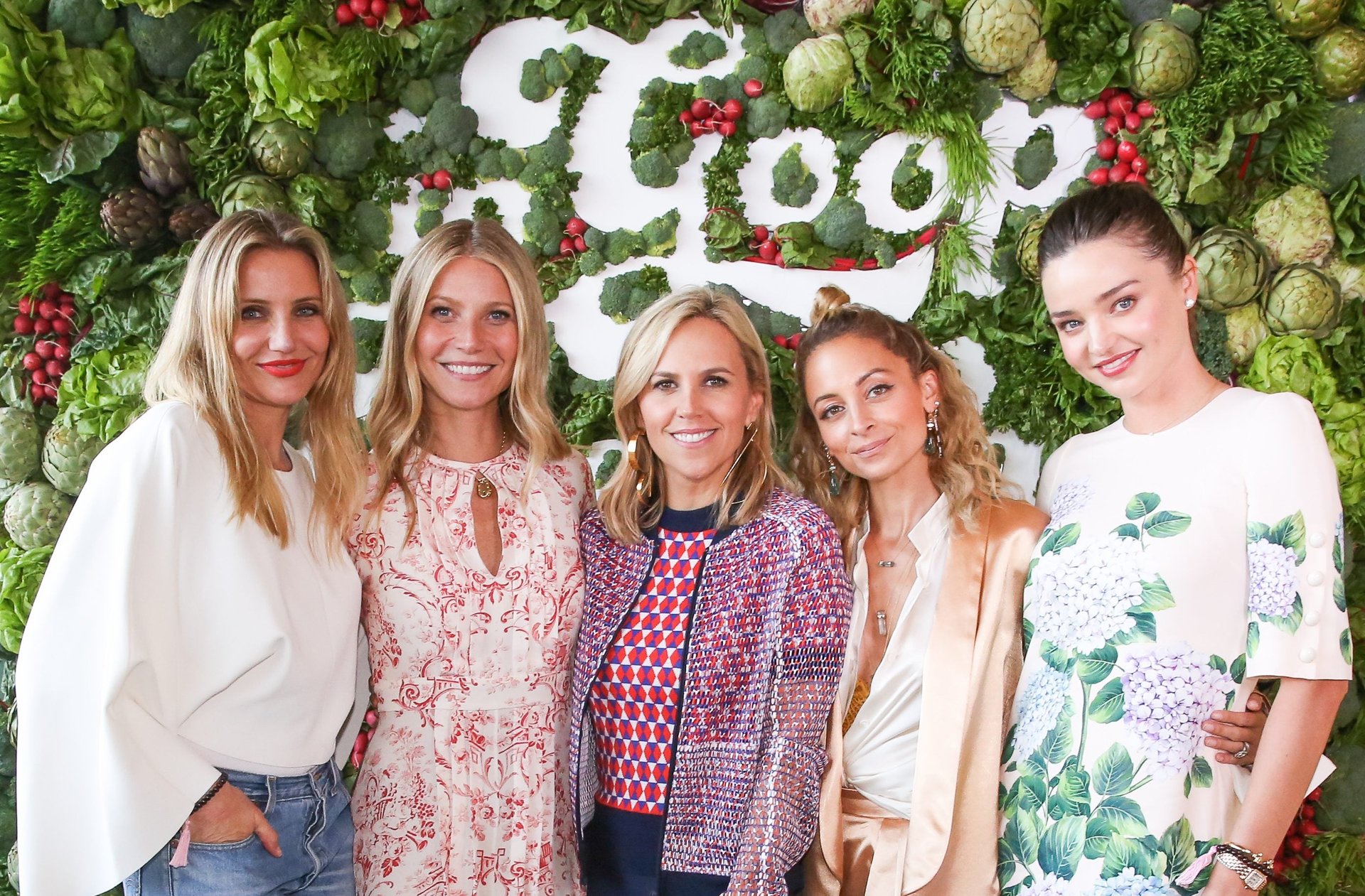
Backstage, Jenni Konner, Lena Dunham’s co-showrunner on Girls and co-founder of the feminist newsletter, Lenny Letter, acknowledged Goop might be a bit of a celebrity-driven cult, but added that it carries value as an important driver of feminism.
“It’s all about women trying to find their power, whether it’s through health or wellness or exercise,” she said, before taking the stage for a panel about women and sex. “Anything that puts a woman in charge of her own body is valuable.”
In the final discussion of the day, Paltrow sat onstage with her friends, Diaz, Burch, Kerr, and Richie.
During an otherwise conventional conversation about maintaining balance between family, work, and health, Kerr shared that she had tried leech therapy, allowing a practitioner to place an amphibious, blood-sucking worm on her lower back, “to detoxify.”
“I had a leech facial as well,” she said. “And I kept the leeches. They’re in my koi pond.”
“Wow!” Paltrow laughed. “I thought I was batshit-crazy!”
After the panels closed, and as the highest-paying ticket-holders adjourned for a glass of rosé in Paltrow’s presence, a grey-haired woman wearing glasses, a cardigan sweater, and thick-soled flip-flops took a banana from a table piled high with fruit in the middle of Goop Hall.
“I personally have been on a wellness journey after being diagnosed with some autoimmune issues,” she said. She’d traveled alone from Philadelphia to attend the event, and was surprised how many others came by themselves, and how friendly they were.
“I thought about it for a couple days…it’s a lot of money,” she said. “I said, ‘I deserve it.'”
And then she stepped outside for her crystal therapy appointment.